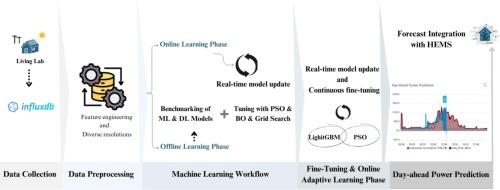Day-ahead residential power load forecasting using adaptive online learning and Particle Swarm Optimization
IF 9.9
1区 工程技术
Q1 COMPUTER SCIENCE, ARTIFICIAL INTELLIGENCE
引用次数: 0
Abstract
Day-ahead load forecasting is essential for improving residential energy management strategies. This study presents a self-learning system using the Light Gradient Boosting Machine (LightGBM) model within an online learning approach to predict residential electricity consumption. The proposed method addresses concept drift through real-time error tracking and adaptive learning, ensuring sustained predictive accuracy in dynamic environments. By leveraging its efficiency, the system achieves high performance while avoiding the complexity and resource demands typically associated with deep learning models.
The forecasting system was deployed in a living lab located in Morocco, integrating both offline and online learning. Throughout a 16-month period, high-resolution, real-time power consumption data was collected. The offline phase involved benchmarking several machine learning models, testing different time resolutions and feature combinations, and identifying the optimal configuration. Hyperparameter tuning was conducted using both Bayesian Optimization (BO) and Particle Swarm Optimization (PSO), with the most effective setup applied in the online phase. The online model operates in real time, automating data collection, prediction, and integration with Home Energy Management Systems, thereby enabling continuous monitoring and adaptation. The LightGBM model consistently achieved R2 scores ranging from 80% to 90%, with PSO providing dynamic fine-tuning of hyperparameters to adapt to changing consumption patterns. To assess generalizability, the model was tested on two external datasets: a public residential dataset and an office building dataset from the ASHRAE Global Occupant Behavior Database. Despite the domain shift, the model maintained strong performance.
These findings highlight the system’s robustness and its appropriateness for informed smart energy decision-making.

基于自适应在线学习和粒子群优化的日前住宅电力负荷预测
日前负荷预测对于提高居民能源管理策略至关重要。本研究提出了一个使用在线学习方法中的光梯度增强机(LightGBM)模型的自学习系统来预测住宅用电量。该方法通过实时误差跟踪和自适应学习来解决概念漂移问题,确保在动态环境中保持预测精度。通过利用其效率,系统实现了高性能,同时避免了通常与深度学习模型相关的复杂性和资源需求。该预测系统部署在摩洛哥的一个生活实验室,整合了离线和在线学习。在16个月的时间里,收集了高分辨率的实时功耗数据。离线阶段包括对几个机器学习模型进行基准测试,测试不同的时间分辨率和特征组合,并确定最佳配置。采用贝叶斯优化(BO)和粒子群优化(PSO)进行超参数整定,并在在线阶段采用最有效的设置。在线模型实时运行,自动化数据收集、预测,并与家庭能源管理系统集成,从而实现持续监测和适应。LightGBM模型的R2得分始终在80%到90%之间,PSO提供了超参数的动态微调,以适应不断变化的消费模式。为了评估通用性,该模型在两个外部数据集上进行了测试:来自ASHRAE全球居住者行为数据库的公共住宅数据集和办公楼数据集。尽管发生了领域转移,该模型仍保持了良好的性能。这些发现突出了该系统的稳健性及其对明智的能源决策的适用性。
本文章由计算机程序翻译,如有差异,请以英文原文为准。
求助全文
约1分钟内获得全文
求助全文
来源期刊

Advanced Engineering Informatics
工程技术-工程:综合
CiteScore
12.40
自引率
18.20%
发文量
292
审稿时长
45 days
期刊介绍:
Advanced Engineering Informatics is an international Journal that solicits research papers with an emphasis on 'knowledge' and 'engineering applications'. The Journal seeks original papers that report progress in applying methods of engineering informatics. These papers should have engineering relevance and help provide a scientific base for more reliable, spontaneous, and creative engineering decision-making. Additionally, papers should demonstrate the science of supporting knowledge-intensive engineering tasks and validate the generality, power, and scalability of new methods through rigorous evaluation, preferably both qualitatively and quantitatively. Abstracting and indexing for Advanced Engineering Informatics include Science Citation Index Expanded, Scopus and INSPEC.
 求助内容:
求助内容: 应助结果提醒方式:
应助结果提醒方式:


